Abstract
By infusing saline intrathecally at a constant rate until a new steady-state cerebrospinal fluid (CSF) pressure is attained, one can estimate clinically the apparent resistance (Ra) to drainage of CSF in mm saline/ml./minute. This intrathecal saline infusion test (ITSIT) was performed 36 times on 29 patients with diverse intracranial problems, and the results were analysed and, in most cases, compared with the pneumoencephalogram and the isotope cisternogram. The ITSIT is a safe, simple test to estimate Ra, but factors which are difficult to control (occult leaks from the subarachnoid space; independent fluctuations of CSF pressure) limit its reliability and clinical usefulness. If closely correlated with the clinical syndrome, the pneumoencephalogram, and the isotope cisternogram, an ITSIT may identify decisively the patient who needs a shunt. In addition the ITSIT offers another method by which to investigate the pathophysiological mechanisms of the various states of intracranial hypertension. Results from the test performed on four patients with intracranial hypertension of unknown cause (pseudotumor cerebri) suggest that the underlying mechanism in this condition is probably an impediment to normal CSF drainage.
Full text
PDF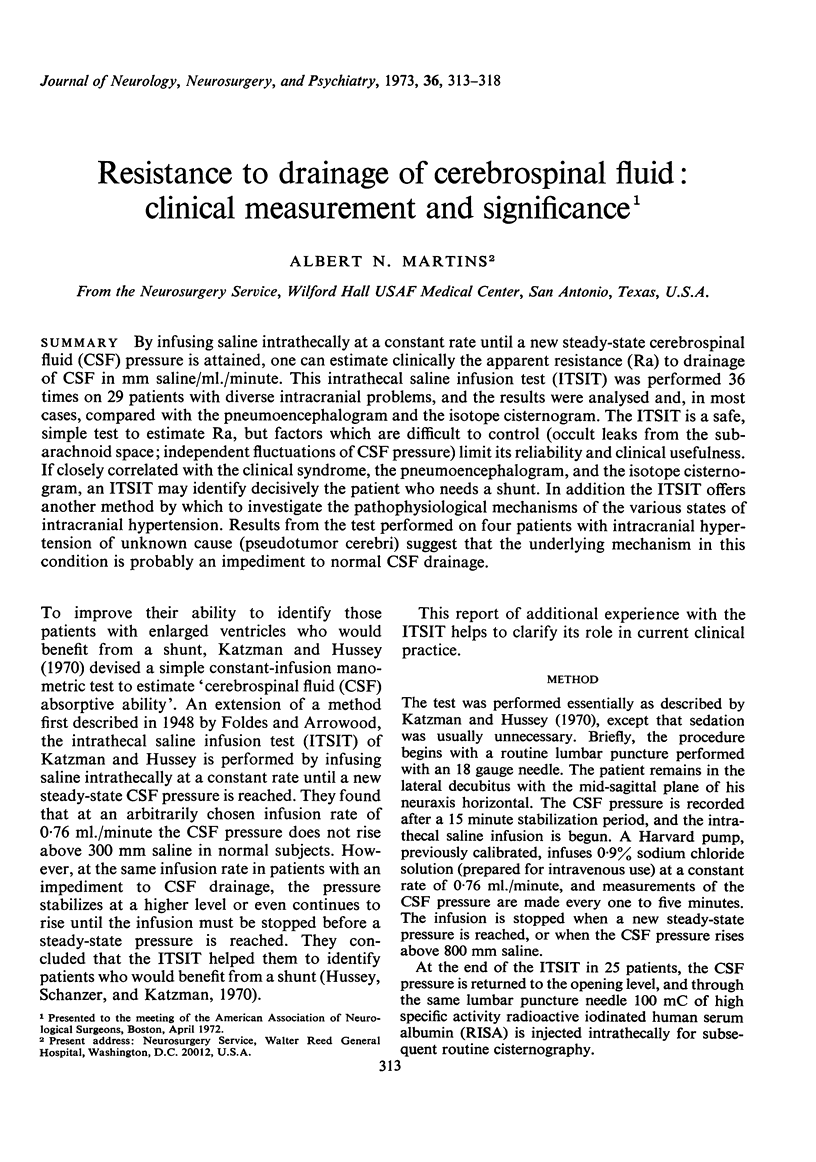
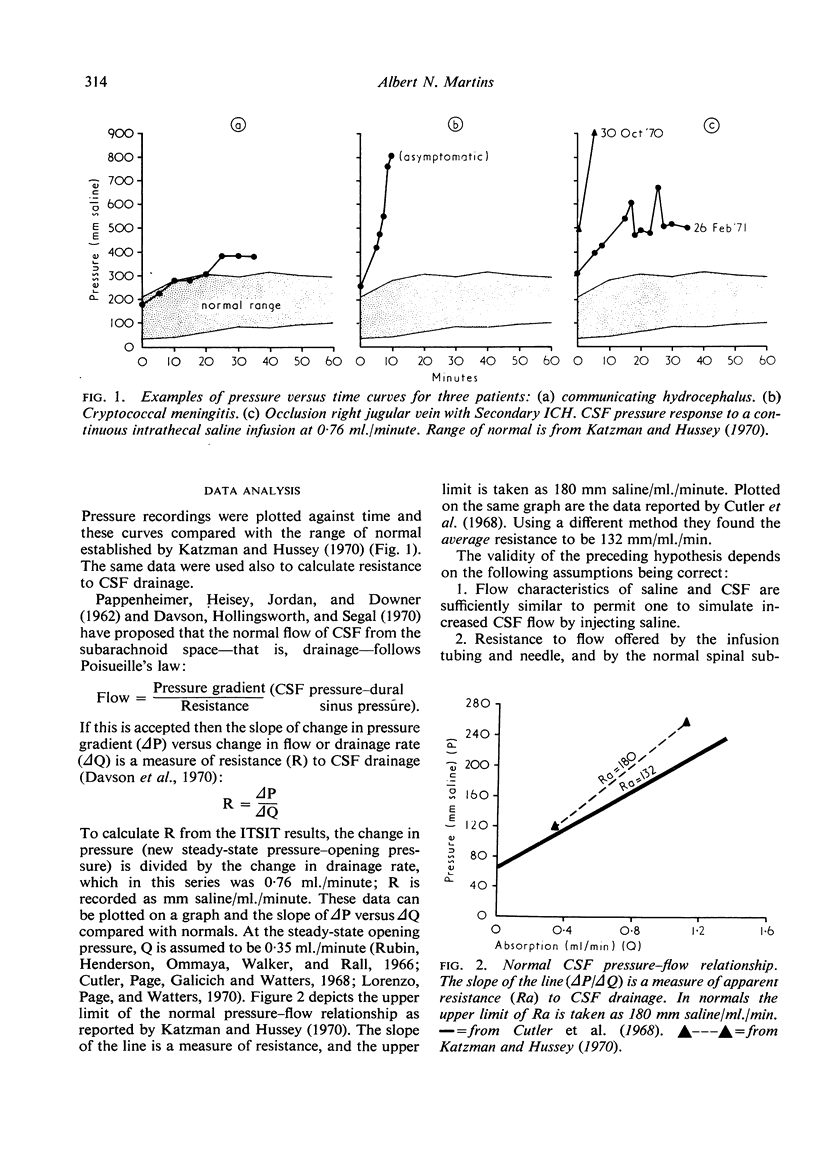
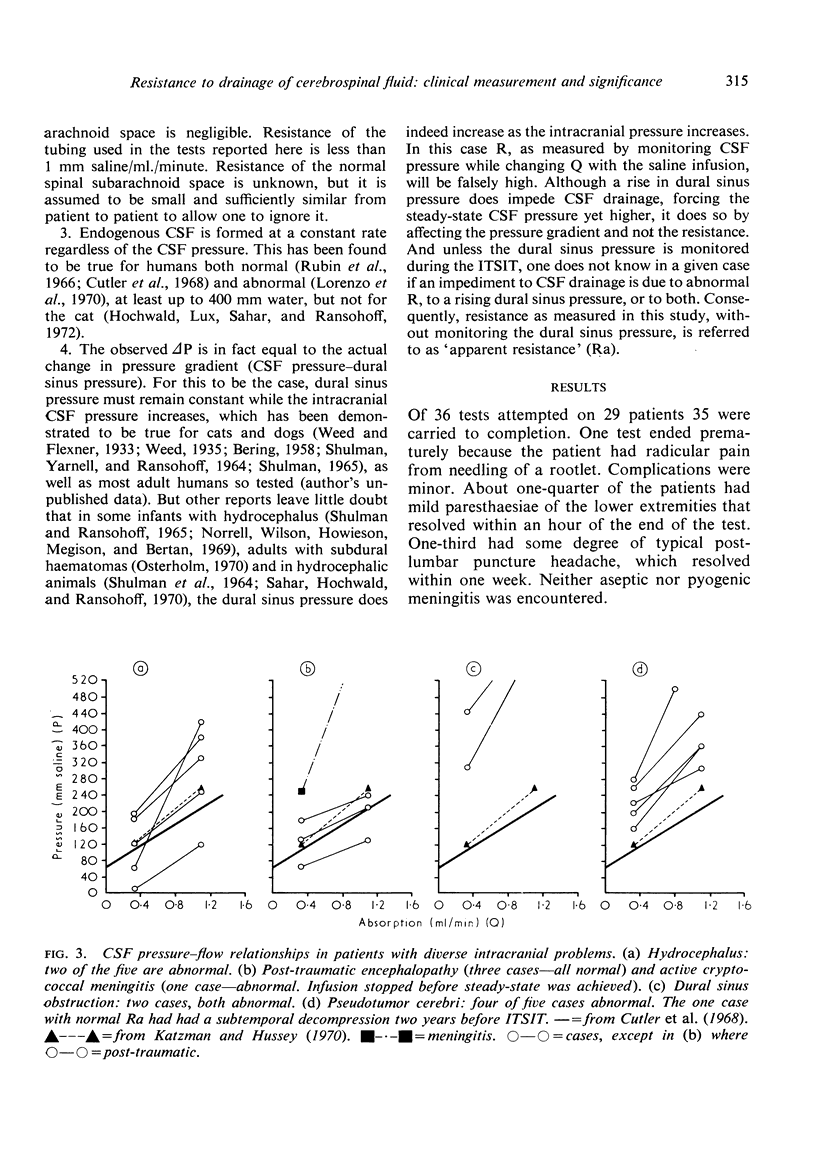
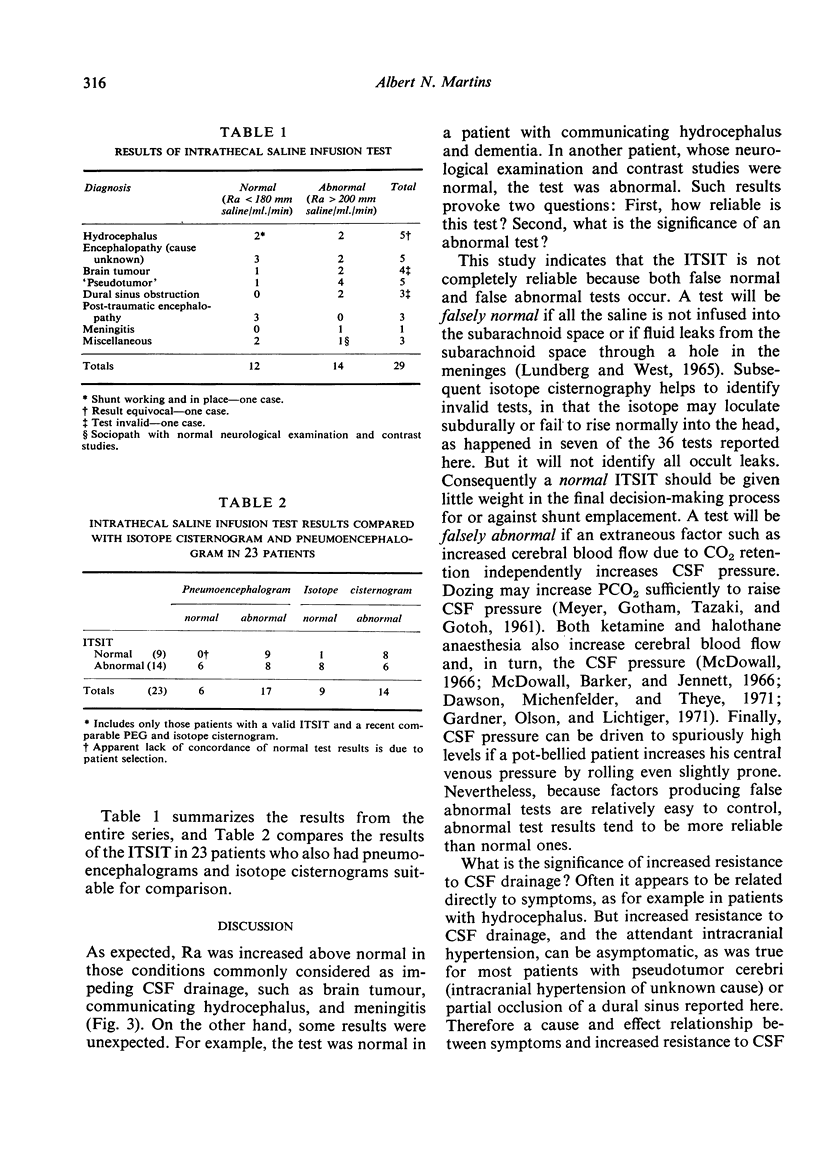
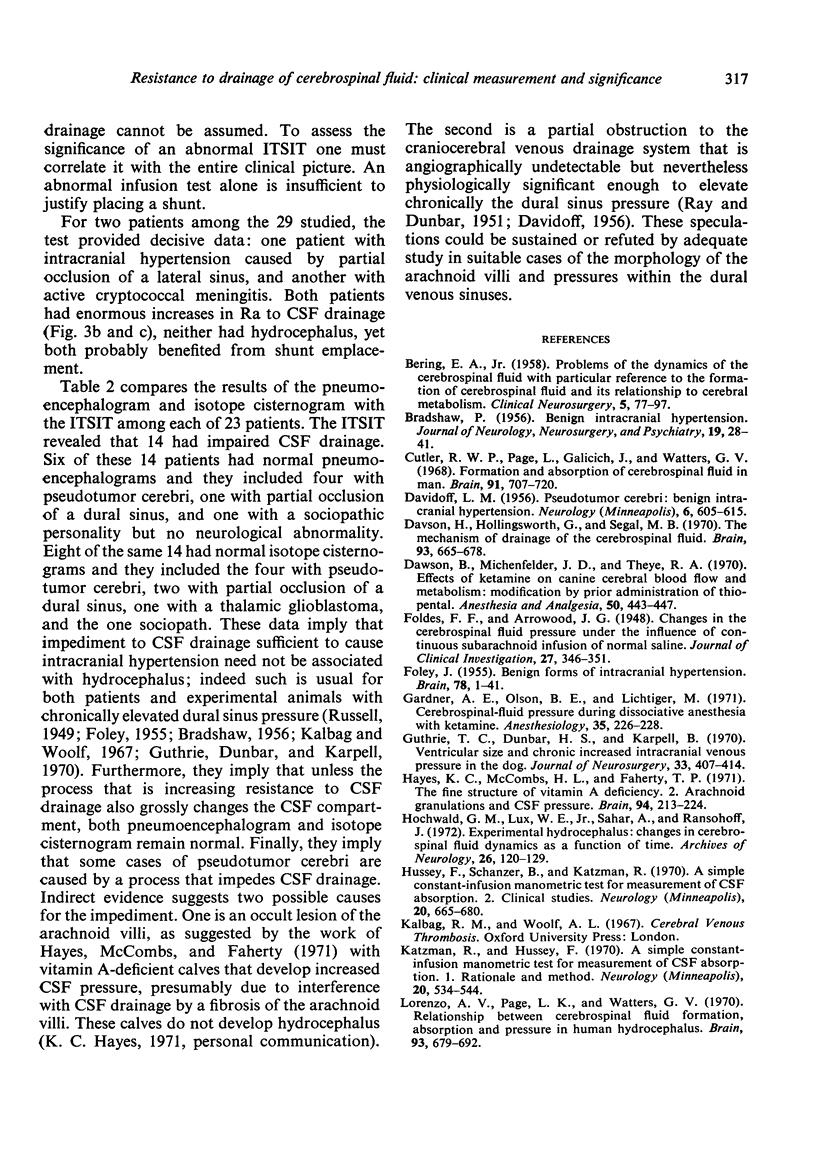
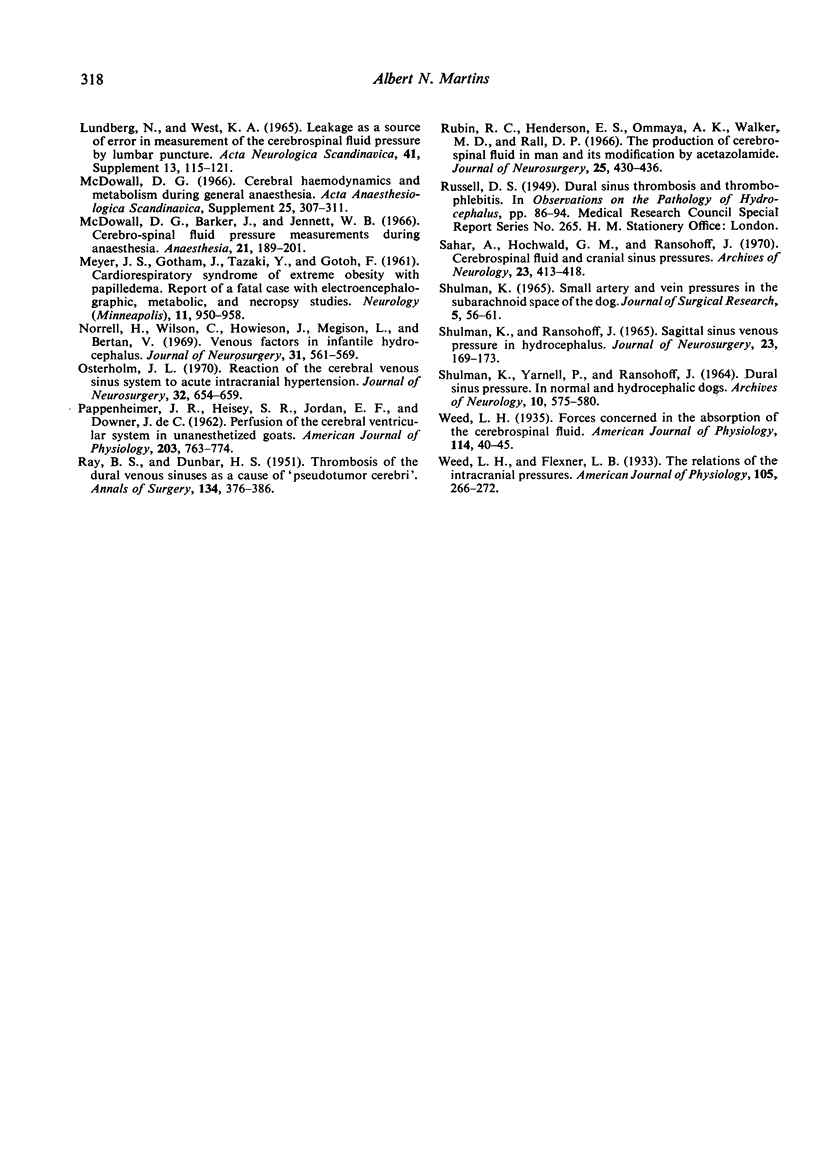
Selected References
These references are in PubMed. This may not be the complete list of references from this article.
- BERING E. A., Jr Problems of the dynamics of the cerebrospinal fluid with particular reference to the formation of cerebrospinal fluid and its relationship to cerebral metabolism. Clin Neurosurg. 1957;5:77–97. doi: 10.1093/neurosurgery/5.cn_suppl_1.77. [DOI] [PubMed] [Google Scholar]
- BRADSHAW P. Benign intracranial hypertension. J Neurol Neurosurg Psychiatry. 1956 Feb;19(1):28–41. doi: 10.1136/jnnp.19.1.28. [DOI] [PMC free article] [PubMed] [Google Scholar]
- Cutler R. W., Page L., Galicich J., Watters G. V. Formation and absorption of cerebrospinal fluid in man. Brain. 1968;91(4):707–720. doi: 10.1093/brain/91.4.707. [DOI] [PubMed] [Google Scholar]
- DAVIDOFF L. M. Pseudotumor cerebri; benign intracranial hypertension. Neurology. 1956 Sep;6(9):605–615. doi: 10.1212/wnl.6.9.605. [DOI] [PubMed] [Google Scholar]
- Davson H., Hollingsworth G., Segal M. B. The mechanism of drainage of the cerebrospinal fluid. Brain. 1970;93(4):665–678. doi: 10.1093/brain/93.4.665. [DOI] [PubMed] [Google Scholar]
- Dawson B., Michenfelder J. D., Theye R. A. Effects of ketamine on canine cerebral blood flow and metabolism: modification by prior administration of thiopental. Anesth Analg. 1971 May-Jun;50(3):443–447. [PubMed] [Google Scholar]
- FOLEY J. Benign forms of intracranial hypertension; toxic and otitic hydrocephalus. Brain. 1955;78(1):1–41. doi: 10.1093/brain/78.1.1. [DOI] [PubMed] [Google Scholar]
- Foldes F. F., Arrowood J. G. CHANGES IN CEREBROSPINAL FLUID PRESSURE UNDER THE INFLUENCE OF CONTINUOUS SUBARACHNOIDAL INFUSION OF NORMAL SALINE. J Clin Invest. 1948 May;27(3 Pt 1):346–351. doi: 10.1172/JCI101965. [DOI] [PMC free article] [PubMed] [Google Scholar]
- Gardner A. E., Olson B. E., Lichtiger M. Cerebrospinal-fluid pressure during dissociative anesthesia with ketamine. Anesthesiology. 1971 Aug;35(2):226–228. doi: 10.1097/00000542-197108000-00029. [DOI] [PubMed] [Google Scholar]
- Guthrie T. C., Dunbar H. S., Karpell B. Ventricular size and chronic increased intracranial venous pressure in the dog. J Neurosurg. 1970 Oct;33(4):407–414. doi: 10.3171/jns.1970.33.4.0407. [DOI] [PubMed] [Google Scholar]
- Hayes K. C., McCombs H. L., Faherty T. P. The fine structure of vitamin A deficiency. II. Arachnoid granulations and CSF pressure. Brain. 1971;94(2):213–224. doi: 10.1093/brain/94.2.213. [DOI] [PubMed] [Google Scholar]
- Hochwald G. M., Lux W. E., Jr, Sahar A., Ransohoff J. Experimental hydrocephalus. Changes in cerebrospinal fluid dynamics as a function of time. Arch Neurol. 1972 Feb;26(2):120–129. doi: 10.1001/archneur.1972.00490080038003. [DOI] [PubMed] [Google Scholar]
- Hussey F., Schanzer B., Katzman R. A simple constant-infusion manometric test for measurement of CSF absorption. II. Clinical studies. Neurology. 1970 Jul;20(7):665–680. doi: 10.1212/wnl.20.7.665. [DOI] [PubMed] [Google Scholar]
- Katzman R., Hussey F. A simple constant-infusion manometric test for measurement of CSF absorption. I. Rationale and method. Neurology. 1970 Jun;20(6):534–544. doi: 10.1212/wnl.20.6.534. [DOI] [PubMed] [Google Scholar]
- Lorenzo A. V., Page L. K., Watters G. V. Relationship between cerebrospinal fluid formation, absorption and pressure in human hydrocephalus. Brain. 1970;93(4):679–692. doi: 10.1093/brain/93.4.679. [DOI] [PubMed] [Google Scholar]
- Lundberg N., West K. A. Leakage as a source of error in measurement of the cerebrospinal fluid pressure by lumbar puncture. Acta Neurol Scand Suppl. 1965;13(Pt 1):115–121. doi: 10.1111/j.1600-0404.1965.tb01865.x. [DOI] [PubMed] [Google Scholar]
- MEYER J. S., GOTHAM J., TAZAKI Y., GOTOH F. Cardiorespiratory syndrome of extreme obesity with papilledema. Report of a fatal case with electroencepholographic, metabolic, and necropsy studies. Neurology. 1961 Nov;11:950–958. doi: 10.1212/wnl.11.11.950. [DOI] [PubMed] [Google Scholar]
- McDowall D. G., Barker J., Jennett W. B. Cerebro-spinal fluid pressure measurements during anaesthesia. Anaesthesia. 1966 Apr;21(2):189–201. doi: 10.1111/j.1365-2044.1966.tb02598.x. [DOI] [PubMed] [Google Scholar]
- McDowall D. G. Cerebral haemodynamics and metabolism during general anaesthesia. Acta Anaesthesiol Scand Suppl. 1966;25:307–311. [PubMed] [Google Scholar]
- Norrell H., Wilson C., Howieson J., Megison L., Bertan V. Venous factors in infantile hydrocephalus. J Neurosurg. 1969 Nov;31(5):561–569. doi: 10.3171/jns.1969.31.5.0561. [DOI] [PubMed] [Google Scholar]
- Osterholm J. L. Reaction of the cerebral venous sinus system to acute intracranial hypertension. J Neurosurg. 1970 Jun;32(6):654–659. doi: 10.3171/jns.1970.32.6.0654. [DOI] [PubMed] [Google Scholar]
- RAY B. S., DUNBAR H. S. Thrombosis of the dural venous sinuses as a cause of pseudotumor cerebri. Ann Surg. 1951 Sep;134(3):376–386. doi: 10.1097/00000658-195113430-00009. [DOI] [PMC free article] [PubMed] [Google Scholar]
- Rubin R. C., Henderson E. S., Ommaya A. K., Walker M. D., Rall D. P. The production of cerebrospinal fluid in man and its modification by acetazolamide. J Neurosurg. 1966 Oct;25(4):430–436. doi: 10.3171/jns.1966.25.4.0430. [DOI] [PubMed] [Google Scholar]
- SHULMAN K. SMALL ARTERY AND VEIN PRESSURES IN THE SUBARACHNOID SPACE OF THE DOG. J Surg Res. 1965 Feb;5:56–61. doi: 10.1016/s0022-4804(65)80067-1. [DOI] [PubMed] [Google Scholar]
- SHULMAN K., YARNELL P., RANSOHOFF J. DURAL SINUS PRESSURE. IN NORMAL AND HYDROCEPHALIC DOGS. Arch Neurol. 1964 Jun;10:575–580. doi: 10.1001/archneur.1964.00460180041003. [DOI] [PubMed] [Google Scholar]
- Sahar A., Hochwald G. M., Ransohoff J. Cerebrospinal fluid and cranial sinus pressures. Relationship in normal and hydrocephalic cats. Arch Neurol. 1970 Nov;23(5):413–418. doi: 10.1001/archneur.1970.00480290033004. [DOI] [PubMed] [Google Scholar]
- Shulman K., Ransohoff J. Sagittal sinus venous pressure in hydrocephalus. J Neurosurg. 1965 Aug;23(2):169–173. doi: 10.3171/jns.1965.23.2.0169. [DOI] [PubMed] [Google Scholar]


